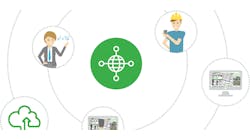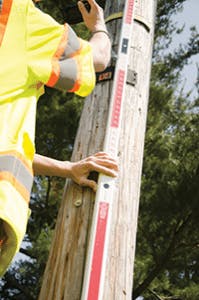Latest from C&E/NetDev Ops/GIS/Open-Source Networks
This article was supposed to be about efficiencies in aerial deployment. You know, the kind of article that gives you 4 action points to put you ahead of everyone else. Who doesn’t want to follow 4 easy steps to greater efficiency? That’s all you’d need to beat the competition, right?
I spent way too much time brainstorming ideas trying to come up with the typical quick, 3-step formula. But the longer I thought about it, the more I realized there are no easy solutions. I can’t just go out and buy a magic tool to speed up my deployment times (despite all the promises from the industry that this or that tool will be my savior).
A fielding team collecting data on a pole using Katapult’s Photogrammetry method.
I work with humans, not robots, and they’re going to make mistakes. If those mistakes are out in the field, they’re going to cost me. And with increasing competition for contracts (and shrinking margins), even the smallest mistakes can be costly. In addition, increasing regulatory pressures require me to speed up my delivery timelines and collect data I didn’t have to worry about back in the day.
If there are no silver bullets, what’s the answer? I propose 2 things, and neither of them are easy to do.
Best Practice #1
Stop the race to the bottom with contract bidding.
What do I mean about a race to the bottom? Every business is different, but one thing is consistent across the board: money. No matter how you slice it, my bid needs to come in below my competitors. At the same time, being the lowest bid isn’t always being the cheapest. Being fast isn’t always faster.
When I talk about efficiency in deployment, what I mean is the company culture that produces the bid. Do I hit my deadlines? Do I re-negotiate terms? Do I know my numbers?
In this industry, it’s difficult to be transparent and firm. You’ve felt that pressure before, too. The pressure to go below what you know your bottom line is. And even if you bid below the point you’re willing to bid, will you make any money on the project?
A worker collecting data at the pole to be used in KatapultPro.
Best Practice #2
Change our mindset about the tools and methods we use for field deployment.
I can have the latest and greatest tools, but still use them inefficiently. And I’m not just talking about training, either. As an industry, we need to think outside of the box when it comes to deployment tools and methods, especially for field collection. Some of the tools we use, even if they are the newest ones, are built on decades-old technology. Yes, they are built to industry standards, but the landscape around us is changing — rapidly.
The newest technology does work and can help me do incredible things, but if I’m not open to using new methods and tools, that’s a problem. It will take time and effort to adapt and change — but I don’t think we have a choice.
The Good News
Though these best practices are challenging, they are doable. But, it takes time and a commitment to do what is right.
Years ago, we used to get beat up by contractors during and after the bidding process. They would ask for everything and want it yesterday. We would say their requests were unreasonable, and then they would hire someone else. Soon after, the newly hired company blew their "Do not exceed" budget, and failed to deliver. Not surprisingly, the contractor would come crawling back to us and ask us to clean up the mess, for less money and tighter deadlines. Could we have done something about that? Sure! But we were under so much pressure to keep the clients we had.
Today, we don’t agree to those relationships because we learned they weren’t worth the paper-thin margins and risk. Was it a risk saying no to clients? Sure it was. As a result, we had some lean times. But in the long run, it’s paid off. We made the decision to work only with companies who understand the difference between short-term and long-term gains. Why jeopardize our relationships with clients by not delivering what we’ve promised?
Is it possible to stop the race to the bottom with contract bidding? It is, but it takes grit.
First, stop intentionally inflating your prices. When you quote numbers, quote real numbers. Figure out how long it takes to measure a pole with a handful of attachments (and that occasional pole with what seems like a million attachments). You might not be the lowest bid today, but you will produce the most consistent results and deliver on time, usually ahead of schedule.
An office employee extracts data out of photos the field team brought back to the office, and delivers them to the client.
Second, build your team. In the long run, you’ll have better project results and higher margins. Use these profits to take better care of your employees. This will build loyalty and allow you to attract better talent, which will help you do a better job, time and time again.
What about technology? How can you leverage it to gain efficiencies?
First, think outside the box. Start with the end goal in mind and see what’s out there. We set out to build an efficient data collection system that would be scalable, easy to learn, and reduce costly joint rideouts and time in the field. Your end goal might be different, but the tools are probably out there. We use just a handful of them, such as Node.js, Polymer, Firebase, AWS, Github, and Cloud9. If you aren’t sure where to start, talk with your contractors. See what they’re doing to innovate and iterate. If they’re not, is it time to look around?
Second, don’t be afraid to take the time and effort to build a custom solution yourself. I realize not everyone can do this, but we’ve seen the clear advantage this gives us. When you develop a product in-house, you can constantly iterate (seeing improvements and features week-by-week), and you no longer rely on others to release a new product version. Is this a big step? Of course, it is, but with the right approach, it can be a game-changer.
Third, be open to using off-the-shelf components (which, let’s be honest, are in many cases better than the professional grade components the industry is used to). This lowers your scaling costs and allows you to ramp up more quickly and efficiently.
As an OSP company, we’re proud to build our products for this industry. We may take a nontraditional path to get there, but in the end, we deliver the same (and often better) data, more quickly and more efficiently. KatapultPro is not a silver bullet. It never will be. But along with a mindset change, it can be the tool that will give you the edge and help you keep it.
Save
Save
Save
Save








